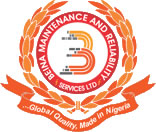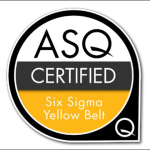ASQ – CSSYB: The certified Six Sigma Yellow Belt
WHY BECOME A CERTIFIED SIX SIGMA YELLOW BELT?
The Certified Six Sigma Yellow Belt (CSSYB) is new to the world of Six Sigma and has a small role,
interest, or need to develop foundational knowledge. Yellow Belts can be entry-level employees who seek
to improve their world or executive champions who require an overview of Six Sigma and the define,
measure, analyze, improve, and control (DMAIC) model. This certification adopts the approach of advancing the concept and potential of using Six Sigma tools and methodologies within an organization.
The Six Sigma Yellow Belt certification is aimed at those new to the world of Six Sigma who have a small role, interest, or need to develop foundational knowledge. Yellow belts can be entry level employees who seek to improve their world or executive champions who require an overview of Six Sigma and define, measure, analyze, improve and control model (DMAIC).
This certification adopts the approach of advancing the concept and potential of using Six Sigma tools and methodologies within an organization.
What Are the Core Competencies of a CSSYB?
impact of Six Sigma on an organization.
• Improved understanding of project definition as well as team roles and responsibilities.
• Foundational understanding of the measure phase, including process mapping, data collection plans
and techniques, understanding variation, and visually displaying baseline performance.
• Foundational understanding of the analyze phase, including displaying data visually, cause and effect analysis, and verification of root causes.
• Foundational learning of the improve phase, including brainstorming, selecting a solution, and implementation planning.
• Foundational understanding of the control phase, including assessing the results of process improvement, statistical process control overview, and documenting the process.
Requirements & Work Experience
The Certified Six Sigma Yellow Belt has no experience or education requirements. The Certified Six Sigma Yellow Belt is aimed at candidates who have a small role, interest, or need to develop foundational knowledge.
Body of Knowledge (BoK)
Topics in this body of knowledge (BoK) include additional detail in the form of subtext explanations and the cognitive level at which test questions will be written. This information will provide guidance for the candidate preparing to take the exam. The subtext is not intended to limit the subject matter or be all-inclusive of what might be covered in an exam. It is meant to clarify the type of content to be included in the exam. The descriptor in parentheses at the end of each entry refers to the maximum cognitive level at which the topic will be tested. A complete description of cognitive levels is provided at the end of this document.
I. Six Sigma Fundamentals (20 Questions)
Describe the purpose of Six Sigma (reducing variation), its methodology (DMAIC), and its evolution from quality.
Describe the value of Six Sigma to the organization as a whole. (Understand)
B. Lean Foundations and Principles
Describe the purpose of lean (waste elimination) and its methodologies (just-in-time, poka-yoke, kanban, value stream mapping).
C. Six Sigma Roles
and Responsibilities
Define and describe the roles and responsibilities of Six Sigma team members (i.e., individual team members, Yellow Belt, Green Belt, Black Belt, Master Black Belt, process owner, champion, sponsor). (Understand)
D. Team Basics
1. Types of teams
Identify the various types of
teams that operate within an organization (i.e., continuous improvement, self-managed, and cross-functional) and their value. (Understand)
2. Stages of development
Describe the various stages of team evolution: forming, storming, norming, performing, and adjourning. (Understand)
3. Decision-making tools
Define and apply decision making tools such as brainstorming, multi-voting, and nominal group technique (NGT). (Apply)
4. Communication methods
Explain how teams use agendas, meeting minutes, and project status reports, and how they support project success. (Apply)
E. Quality Tools and Six Sigma Metrics
1. Quality tools
Select and use these tools throughout the DMAIC process: Pareto charts, cause and effect diagrams, flowcharts, run charts, check sheets, scatter diagrams, and histograms. (Apply)
2. Six Sigma metrics
Select and use these metrics throughout the DMAIC process: defects per unit (DPU), defects per million opportunities (DPMO), rolled throughput yield (RTY), cycle time, and cost of poor quality (COPQ). (Apply)
II. Define Phase (14 Questions)
A. Project Identification
1. Voice of the customer
Define the voice of the customer and describe how customer needs are translated into quantifiable, critical-to-quality (CTQ) characteristics. (Understand)
2. Project selection
Describe how projects are identified and selected as suitable for a Six Sigma project using the DMAIC methodology. (Understand)
3. Stakeholder analysis
Identify end users, subject matter experts, process owners, and other people or factors that will be affected by a project, and describe how each of them can influence the project. (Understand)
4. Process inputs and outputs
Use SIPOC (suppliers, inputs, process, outputs, customers) to identify and define important elements of a process. (Apply)
5. Supply chain management
Understand supply chain management and how it relates to project management. (Apply)
1. Project charter
Describe the purpose of a charter and its components: problem statement, project scope, baseline data, and project goal. (Understand)
2. Communication plan
Explain the purpose and benefits of a communication plan and how it can impact the success of the project. (Understand)
3. Project planning
Define work breakdown structure (WBS) and Gantt charts, and describe how they are used to plan and monitor projects. (Understand)
4. Project management tools
Select and use various PM tools: activity network diagrams, affinity diagrams, matrix charts, relations charts, and tree diagrams. (Understand)
5. Phase reviews
Explain how tollgate or phase reviews are used throughout the DMAIC lifecycle. (Understand)
III. Measure Phase (15 Questions)
A. Basic Statistics
Define, calculate, and interpret measures of central tendency (mean, median, mode) and understand measures of dispersion (standard deviation, range, variance). (Apply)
B. Data Collection
1. Data collection plans
Describe the critical elements of a data collection plan, including an operational definition, data sources, the method to be used for gathering data, and how frequently it will be gathered.
Describe why data collection plans are important. (Understand)
2. Qualitative and quantitative data
Define and distinguish between these types of data. (Understand)
Use various data collection techniques, including surveys, interviews, check sheets, and checklists to gather data that contributes to the process being improved. (Apply)
C. Measurement System Analysis (MSA)
1. MSA terms
Define precision, accuracy, bias, linearity, and stability, and describe how these terms are applied in the measurement phase. (Understand)
2. Gauge repeatability and reproducibility (GR&R)
Describe and distinguish between repeatability and reproducibility and describe how and why GR&R is used in the measurement phase. (Understand)
A. Process analysis tools
1. Lean tools
Define how 5S and value analysis can be used to identify and eliminate waste. (Understand)
2. Failure mode and effects analysis (FMEA)
Relate the elements of severity, occurrence, and detection, and determine how they are used to calculate the risk priority number.
Demonstrate how FMEA can be used to identify potential failures in a process. (Apply)
B. Root cause analysis
Describe how the 5 Whys, process mapping, 8D, force-field analysis, and matrix charts can be used to identify the root causes of a problem. (Understand)
C. Corrective action
Explain and apply elements of the corrective action process: identify the problem, contain the problem (interim action), determine the causes of the problem and propose solutions to eliminate it or prevent its recurrence (permanent action), verify that the solutions are implemented, and confirm
their effectiveness (validation). (Apply)
D. Preventive action
Explain and apply elements of a preventive action process: understand various process analysis techniques to identify potential failures, defects, or process deficiencies; improve the process (e.g., understand error- or mistake-proofing devices or methods, initiate procedural changes), and verify the effectiveness of the preventive action. (Apply)
E. Data analysis
1. Basic distribution types
Define and distinguish between normal and binomial distributions and describe how their shapes (skewed and bimodal) can affect data interpretation. (Understand)
2. Common and special cause variation
Describe and distinguish between these types of variation. (Understand)
F. Correlation and regression
1. Correlation
Describe how correlation is used to identify relationships between variables. (Understand)
2. Regression
Describe how regression analysis is used to predict outcomes. (Understand)
G. Hypothesis testing
Define and distinguish between hypothesis terms (i.e., null and alternative, type I and type II error, p-value and power). (Understand)
A. Improvement techniques
1. Kaizen and kaizen blitz
Define and distinguish between these two methods and describe how they can be used to make improvements to any process in an organization. (Understand)
2. Plan-do-check-act (PDCA) cycle
Define and distinguish between the steps in this process improvement tool. (Understand)
3. Cost-benefit analysis
Explain the importance of this analysis and how it is used in the improve phase. (Understand)
B. Control Tools and Documentation
1. Control plan
Describe the importance of a control plan for maintaining improvements. (Understand)
2. Control charts
Describe how X-R charts are used for monitoring and sustaining improved processes. (Understand)
3. Document control
Describe the importance of documenting changes to a process and communicating those changes to stakeholders. (Understand)
4. Work instructions and standard operating procedures (SOPs)
Understand the purpose and use of work instructions and SOPs. (Understand)
General Notes on The BoK:
The topics in this Body of Knowledge include additional detail in the form of subtext explanations and the cognitive level at which test questions will be written. This information will provide guidance for the candidate preparing to take the exam.
The subtext is not intended to limit the subject matter or be all-inclusive of what might be covered in an exam. It is meant to clarify the type of content to be included in the exam. The descriptor in parentheses at the end of each entry refers to the maximum cognitive level at which the topic will be tested. A complete description of cognitive levels is provided at the end of this document.
Email Addresses
info@beinareliability.com,
training@beinareliability.com,
certifications@beinareliability.com,
procurements@beinareliability.com,
services@beinareliability.com
Phone Numbers
+234(0)8035470560
+234(0)9045559549
+234(0)9099636439,
+234(0)9061984306,
+234(0)8029184653,
Subscribe For Updates
Copyright © 2025 Beina Maintenance & Reliability Services LLC™. Website by Exploits Mediatech



